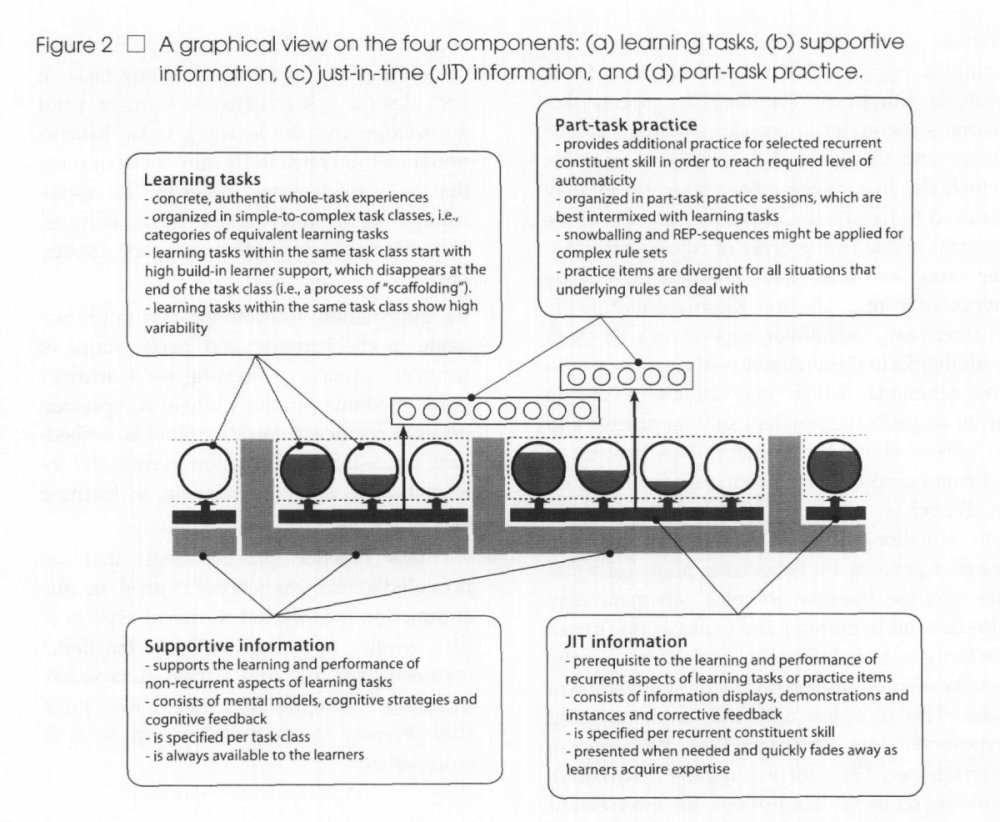4C-ID: Difference between revisions
(using an external editor) |
m (using an external editor) |
||
| Line 28: | Line 28: | ||
* van Merriënboer, J.J.G (1997). Training complex cognitive skills: A four-component instructional design model for technical training. Englewood Cliffs, NJ: Educational Technology Publications | * van Merriënboer, J.J.G (1997). Training complex cognitive skills: A four-component instructional design model for technical training. Englewood Cliffs, NJ: Educational Technology Publications | ||
* van Merriënboer, Jeroen.J.G, Richard E Clark, Marcel B M de Croock, (2002) Blueprints for complex learning: The 4C/ID-model, Educational Technology, Research and Development. 50 (2);39-64, DOI: 0.1007/BF02504993, [http://www.springerlink.com/content/f50848474x68046t/ Abstract/PDF] {{ar}} | * van Merriënboer, Jeroen.J.G, Richard E Clark, Marcel B M de Croock, (2002) Blueprints for complex learning: The 4C/ID-model, Educational Technology, Research and Development. 50 (2);39-64, DOI: 0.1007/BF02504993, [http://www.springerlink.com/content/f50848474x68046t/ Abstract/PDF] {{ar}}. | ||
* Frederick Kwaku Sarfo & Jan Elen, Powerful Learning Environments and the Development of Technical Expertise in Ghana: Investigating the Moderating Effect of Instructional Conceptions, IEEE Explore, ??? [http://ieeexplore.ieee.org/iel5/10084/32317/01508880.pdf PDF] | * Frederick Kwaku Sarfo & Jan Elen, Powerful Learning Environments and the Development of Technical Expertise in Ghana: Investigating the Moderating Effect of Instructional Conceptions, IEEE Explore, ??? [http://ieeexplore.ieee.org/iel5/10084/32317/01508880.pdf PDF] | ||
[[Category: Instructional design models]] | [[Category: Instructional design models]] | ||
Revision as of 15:56, 6 February 2007
Definition
- 4C/ID is an instructional design model by van Merriënboer and others.
- "4C" means "four components", "ID" means "Instructional Design". It also can be found in Merril's first principles of instruction.
- According to Martin Ryder, the The 4C-ID instructional model is characterized by four components: (1) Learning Tasks, (2) Supportive Information, (3) Procedural Information and (4) Part-Task Practice. The task are ordered by task difficulty and each task offers at the beginning a lot of scaffolding which is reduced as the learner progresses.
See also: Elaboration theory (a much early model from Reigeluth).
The design
4C/ID is what I call a "main-stream" Instructional Design Model that addresses the issue of how to teach complex skills, i.e. solid know-how that can be applied to real problem problems.
According to Merriënboer et al. (2002): “The 4C/ID-model [....] addresses at least three deficits in previous instructional design models. First, the 4C/ID-model focuses on the integration and coordinated performance of task-specific constituent skills rather than on knowledge types, context or presentation-delivery media. Second, the model makes a critical distinction between supportive information and required just-in-time (JIT) information (the latter specifies the performance required, not only the type of knowledge required). And third, traditional models use either part-task or whole-task practice; the 4C/IDmodel recommends a mixture where part-task practice supports very complex, "whole-task" learning.”
According to Merril (2002:56), the model is clearly problem-based although not in the sense of typical problem-based learning models. “At the heart of this training strategy is whole-task practice, in which more and more complex versions of the whole complex cognitive skill are practiced. In ... the analysis phase ... the skill is decomposed in a hierarchy of constituent skills; ... classified as recurrent constituent skills, which require more-or-less consistent performance over problem situations, or nonrecurrent constituent skills, which require highly variable performance over situations" (p. 8). "While learners practice simple to complex versions of a whole task, instructional methods that promote just-intime information presentation are used to support the recurrent aspects of the whole task while, at the same time, instructional methods that promote elaboration are used to support the non-recurrent aspects of the task" (p. 10).”
The four components are described in detail in Merrienboer (2002) and from which this picture is taken:

References
- Merrill, David, First Principles of Instruction, ETR&D, Vol. 50, No. 3, 2002, pp. 43-59 ISSN 1042-1629. Preprint version
- van Merriënboer, J.J.G (1997). Training complex cognitive skills: A four-component instructional design model for technical training. Englewood Cliffs, NJ: Educational Technology Publications
- van Merriënboer, Jeroen.J.G, Richard E Clark, Marcel B M de Croock, (2002) Blueprints for complex learning: The 4C/ID-model, Educational Technology, Research and Development. 50 (2);39-64, DOI: 0.1007/BF02504993, Abstract/PDF (Access restricted).
- Frederick Kwaku Sarfo & Jan Elen, Powerful Learning Environments and the Development of Technical Expertise in Ghana: Investigating the Moderating Effect of Instructional Conceptions, IEEE Explore, ??? PDF